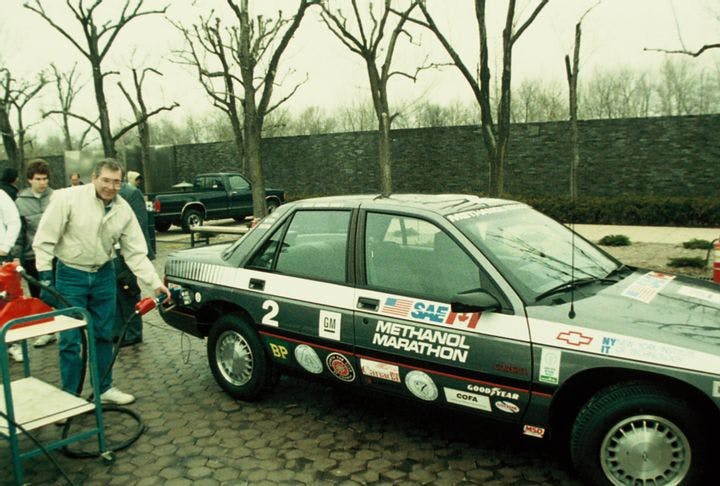Can methanol fuel OPEC's demise?
– Erin Amato
It's cleaner, safer, cheaper, and easily used in flex-fuel vehicles.
Any American politician who calls America “the Saudi Arabia of coal” is likely aware of Saudi Arabia’s oil reserves. Even President Obama has christened America “the Saudi Arabia of natural gas” after hydraulic fracturing, or “fracking,” increased from 1.3 trillion to 8 trillion cubic feet in 2011. No doubt the U.S. is considering alternatives to avoid being taken hostage by the fixed prices of OPEC, the Organization of Petroleum Exporting Countries in the Middle East with vast oil reserves.
Those who imagine a future where natural gas has freed America from the yoke of OPEC are wagering on the wrong fuel source; “The effects of the boom … will be neither as great nor as lasting as might be expected,” asserts Robert Zubrin, a contributing editor for The New Atlantis.
First of all, the United States consumes energy prodigiously: in 2012, over 18 million barrels of oil are used daily, compared to about 10 million by China, the world’s second-leading consumer. America’s status as the world’s largest oil importer isn’t likely to change any time soon, and given that shale natural gas production is expected to plateau starting as soon as 2020, relying on a neverending supply of natural gas fields isn’t feasible. Just because domestic oil production rises doesn’t mean prices will fall: “the power of OPEC to distort the oil market is unequaled, with grave consequences for the global economy.”
Zubrin’s solution? Fueling cars with Methanol. It’s cleaner for the environment, safer and less combustible, cheaper than gasoline, and easily used in flex-fuel vehicles by spending just fifty cents to install a methane-impervious seal for fuel systems. What stands in the way of an energy revolution and economic boost is Wall Street and the EPA: EPA regulations prohibit altering fuel systems of cars and charge a hefty fine to individuals and manufacturers who attempt to switch to methanol without obtaining a license.
It’s a daunting task — Sisyphean, perhaps — to develop a methanol market by adding filling stations and educating the public, but Zubrin claims to be up for the challenge. He purports to have spent just 50 cents on converting his Chevy Cobalt to methanol (thanks largely to built-in “flex-fuel” capacity available in many consumer cars), and believes that other Americans would follow suit if they simply had the knowledge available to them. The solution to America’s OPEC woes “lies in a relatively simple policy proposal,” Zubrin concludes. “Auto manufacturers should be required by law to have a true flex-fuel capability” in new cars sold.
But perhaps we shouldn’t put on those rose-colored glasses just yet. Jim Efstathiou Jr. of Bloomberg urges skepticism for readers who believe methanol can be easily introduced into the market. Echoing the arguments of John Floren, CEO of Vancouver-based Methanex Corporation, he points out that the U.S., at the most basic level, lacks the production capacity for all this new methanol, and without the influential backing of America’s corn-growers (who themselves hold significant sway in Iowa’s presidential caucuses), domestic ethanol producers out-lobby methanol makers by a 50 to 1 rate. Patrick Davis, director of the Energy Department’s Vehicle Technologies Office, identifies another hurdle in the distribution process: “a lack of infrastructure to produce and deliver methanol to fueling stations” that are sparsely located.
Zubrin brushes aside such skeptics’ predictions, focusing on a legislative solution instead of a market solution. He calls for the passage of the Open Fuel Standard Act, which would require alternative fueling options (e.g. flex-fuel capabilities) in at least 30 percent of automakers’ fleets by model year 2016, and 50 percent from 2017 onward. The mandate, imagines Zubrin, would “lead foreign auto manufacturers also to offer more flex-fuel cars” and increase “the downpour of additional supply drowning OPEC.”
Faced with alternative fuel sources, Zubrin believes the U.S. could put OPEC in a chokehold instead of the other way around. OPEC would have to concede its price-fixing advantages and conform to market prices or else risk a sharp decline in oil demand: “it is reasonable to estimate that, in this scenario, oil and gasoline would be selling at about half of their current prices,” claims Zubrin.
The Source: “Why and How We Should Break OPEC Now” by Robert Zubrin. The New Atlantis. Fall 2013.
Photo courtesy of Flickr/doeavtc
